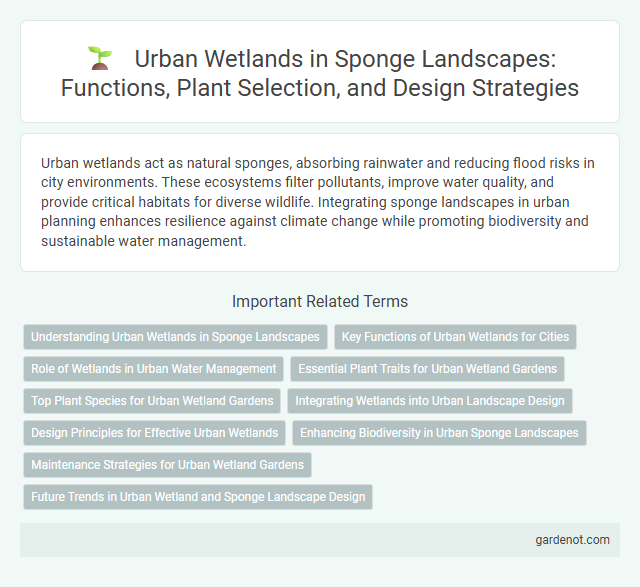Urban wetlands act as natural sponges, absorbing rainwater and reducing flood risks in city environments. These ecosystems filter pollutants, improve water quality, and provide critical habitats for diverse wildlife. Integrating sponge landscapes in urban planning enhances resilience against climate change while promoting biodiversity and sustainable water management.
Understanding Urban Wetlands in Sponge Landscapes
Urban wetlands in sponge landscapes serve as critical natural infrastructure that enhances stormwater management by absorbing, filtering, and slowly releasing runoff. These ecosystems provide essential habitats for biodiversity, improve water quality by trapping pollutants, and reduce urban flooding risks. Effective integration of urban wetlands in city planning supports sustainable water cycles and promotes resilience against climate change impacts.
Key Functions of Urban Wetlands for Cities
Urban wetlands play a crucial role in stormwater management by acting as natural sponges that absorb and filter runoff, reducing flood risks in densely populated areas. They enhance water quality by trapping pollutants, sediments, and nutrients, thus protecting downstream ecosystems and urban water supplies. These ecosystems also provide essential habitats for biodiversity, support groundwater recharge, and help mitigate urban heat island effects through evapotranspiration.
Role of Wetlands in Urban Water Management
Urban wetlands act as natural sponges, absorbing excess rainwater and reducing flood risks in densely populated areas. These ecosystems filter pollutants, improving water quality by trapping sediments and breaking down contaminants before water enters rivers or groundwater supplies. Integrating wetlands into urban planning enhances groundwater recharge, supports biodiversity, and mitigates the impacts of stormwater runoff.
Essential Plant Traits for Urban Wetland Gardens
Urban wetland gardens thrive with plants exhibiting high water tolerance, efficient nutrient uptake, and robust root systems for soil stabilization. Species such as cattails (Typha spp.), bulrushes (Schoenoplectus spp.), and sedges (Carex spp.) are essential for enhancing filtration and habitat complexity. These traits support water retention, improve biodiversity, and contribute to the overall resilience of sponge landscapes in urban environments.
Top Plant Species for Urban Wetland Gardens
Top plant species for urban wetland gardens include native sedges (Carex spp.), which enhance water filtration and provide habitat for wildlife. Cattails (Typha latifolia) excel at stabilizing soil and improving water quality by absorbing excess nutrients. Pickerelweed (Pontederia cordata) offers vibrant flowers that support pollinators while contributing to the ecological balance of urban sponge landscapes.
Integrating Wetlands into Urban Landscape Design
Integrating urban wetlands into landscape design enhances stormwater management by naturally filtering pollutants and reducing runoff volumes. These wetlands promote biodiversity by providing habitat for native flora and fauna, contributing to ecosystem resilience within city environments. Incorporating wetland features supports climate adaptation strategies by mitigating urban heat islands and managing flood risks effectively.
Design Principles for Effective Urban Wetlands
Urban wetland design principles emphasize maximizing water retention through permeability and native vegetation to enhance natural filtration and biodiversity. Incorporating multifunctional landscapes supports flood mitigation, habitat creation, and recreational opportunities, optimizing ecosystem services in dense urban areas. Strategic layering of plant species and hydrological zones ensures resilience, improving water quality and promoting sustainable urban water management.
Enhancing Biodiversity in Urban Sponge Landscapes
Urban sponge landscapes integrate wetlands that serve as critical habitats supporting diverse flora and fauna, thereby enhancing urban biodiversity. These wetlands improve ecological connectivity by providing refuges for native species and facilitating natural water filtration, which sustains microhabitats. Incorporating native plant species in urban wetlands maximizes ecological functions, promoting resilience and biodiversity within densely populated areas.
Maintenance Strategies for Urban Wetland Gardens
Effective maintenance strategies for urban wetland gardens include regular monitoring of water quality to prevent pollution and sustain native biodiversity. Implementing adaptive water level management enhances habitat conditions for wetland species and controls invasive plant growth. Routine removal of debris and strategic planting of native vegetation support ecosystem resilience and improve urban water filtration.
Future Trends in Urban Wetland and Sponge Landscape Design
Future trends in urban wetland and sponge landscape design emphasize integrating smart water management technologies to enhance flood control and water quality. Increasing adoption of bioengineering techniques and native vegetation supports ecosystem resilience and biodiversity in urban environments. These innovations align with sustainable city planning goals, promoting climate adaptation and improved urban liveability.
Urban wetland Infographic

 gardenot.com
gardenot.com